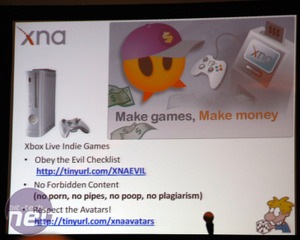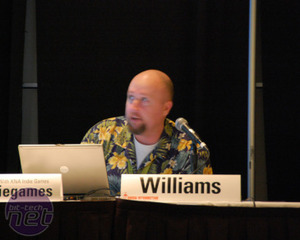
The future of touch
Patel and Glofcheskie then went on to talk about how they thought touch-screen gaming would develop. Both were clear in their belief that we’ll see more and more touch sensitive devices, with Glofcheskie talking about how he thought touch-screens fitted into the history of the development of tools.As he saw it, “tools are prosthetics of existing human functions – what is a hammer but an extension of your fist? A flute is a prosthetic of your voice. These tools then amplify, as we can use tools to make bigger, more powerful tools – but eventually this stops, and digitalisation makes things smaller, and multi-touch makes the tools more intimate, more connected to us once more… Multi-touch means the degree of separation between the hand and the tool is collapsing. Input and output devices are converging, and that to me is the future of multi-touch.”
The three games of the last page come free with any touch device you buy now (there are 46 or so such devices, we were told) as part of the Microsoft Touch Pack for Windows 7 and Patel claimed Microsoft were looking in to providing them as a free download.
XNA: development for everyone
While Microsoft’s presentation on touch-screen gaming looked at concepts for the future, its session on XNA was more focussed on the here and now. It’s the development framework of choice for indie games, according to independent games developer and XNA advocate Chris G. Williams, as it presents an incredible opportunity for indie developers to access Microsoft's vast user base across Xbox 360, PC, Zune, the Surface and the upcoming Windows Phone 7 Series. Using XNA means an astonishing 90 per cent of a game’s code remains constant across all platforms.Williams was keen to stress the XNA route isn’t just efficient with code, but with cash too. Microsoft enables indie developers to take advantage of Microsoft Visual C# Express, a free version of the seriously expensive Visual Studio, which also works with the latest version of XNA Game Studio, which are free downloads. As a result the startup costs for non-studio developers are virtually nil.
Williams then used his talk at SXSW to demonstrate how easy XNA makes it to start developing games. It comes with specialised classes for dealing with thorny common problems such as sprite animation and game timing. The latter is particularly important, as it helps ensure games run at a consistent speed across a range of devices and processors.
Williams gave an overview of many of XNA’s core functions, highlighting the content pipeline for pre-rendering art assets, use of XACT and an Audio API for handling banks of sound, He also talked about the weaknesses, such as the limitations inherent in Microsoft’s implementation for High Level Shader Language (HLSL).

MSI MPG Velox 100R Chassis Review
October 14 2021 | 15:04











Want to comment? Please log in.